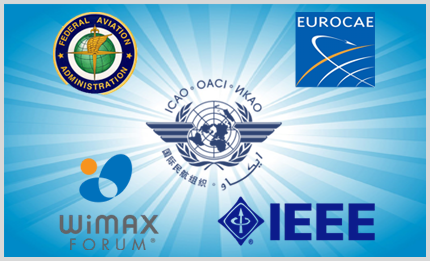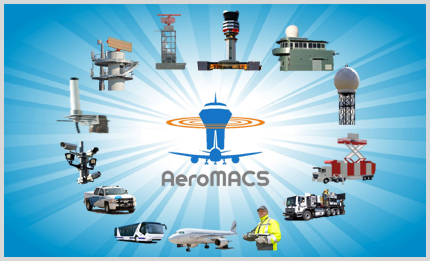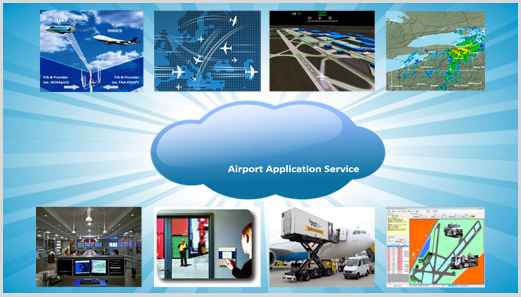Airport Management System Over AeroMACS (AMSx) is a futuristic airport management system built upon the AeroMACS surface communication technology. AMSx is a total solution to manage the airport operations with enhanced real-time situational awareness in to every other airport. AMSx hosts applications and services for airport operations, air traffic control and airline operations.
AMSx integrates the airport applications and operations with intelligent automation. The landside and airside activities are synchronized with real-time operations data. The integration is extendable to multiple airports, regions and country with centralized infrastructure control. AMSx implements advanced communication, command and control features to build a reliable, accurate and efficient airport management system.
Celestain undertakes turnkey projects with the complete scope of study, analysis, planning, implementation, installation, integration and commissioning of AMSx. Celestain installs PoC in the airports to demonstrate the AMSx functions and features. Please contact us for further information.
AMSx airport wireless mobile access network is implemented by the AeroMACS communication system. AeroMACS is the future surface communication system in the SESAR and NextGen Programs. AeroMACS is based on IEEE 802.16-2009 technology. AeroMACS features enhances the reliability, security and bandwidth capability of airport surface communication.
( a ) Control ( b ) Reliability ( c ) Performance ( d ) Capacity ( e ) Per-bit cost performance ( f ) Cost of infrastructure ( g ) Ease of installation

AeroMACS profile, characteristics, specifications and applications are detailed in the following industry standards and publications :

Mobile and static wireless subscriber stations are connected to the access network as shown in the picture.
The mobile AeroMACS subscriber stations include aircrafts (on-ground), service vehicles and hand-held terminals.
Static subscribers include all the equipment (airport operation, airline, ANSP, meteorological, weather) capable of AeroMACS wireless communication.
AMSx makes this wireless connectivity possible by installing suitable wireless sensors in the following airport equipment :
AMSx establishes communication with the AeroMACS static subscriber for the following purposes :
AeroMACS network reference model and interfaces are defined in the FAA’s EB-97 and WiMAX Forum’s Network Architecture. AeroMACS Access Network is connected to the airport local area networks such as airport operation, ANSP, Airlines and Service Providers. An airport network is formed by one or more access networks and the local area networks in the airport.

AMSx interconnects the airport networks over the private IP internetwork. The internetworking infrastructure can be located in a central or distributed locations. The network architecture supports single-point connectivity to access the application and information services hosted through the network.
AMSx supports various ISP scenarios for the network and computing architecture. Based on the ISP ownership and the administrative controls among the aviation authority, airport operators and service provider organizations, AMSx implements the following architectures:
• Centralized Cloud Computing and Service Delivery Architecture
• Centralized Network Services with Distributed Computing and Service Delivery Architecture
The architectures determine the network, computing and service delivery responsibilities and revenue models. AMSx supports the service provisioning, metering, SLA monitoring and billing functions.
System Wide Information Management (SWIM) is a new way of managing information along its full lifecycle and its usage across Air Traffic Management (ATM) system. The core concept of SWIM is global interoperability and standardization of information and services.
SWIM benefits the ATM business with common quality benchmarks for information and services. SWIM ensures timely delivery of the right information to the required people. SWIM is transversal across ATM systems, data domains, and business trajectory phases and stakeholders.
AMSx implements and uses SWIM beyond the objectives of information and service delivery. AMSx uses SWIM for global synchronization of operations planning and automation of Airport Management. AMSx maintains SWIM data in real-time, improving the accuracy of situation awareness.
SWIM shares the following kinds of information with its stakeholders. AMSx includes the kinds of information proposed by FAA NextGen and EUROCAE SESAR programs. AMSx scope of SWIM implementation will only meet the customer requirements.
| Operations Data | Status of resources, equipment, flights, operations at the airports |
| Operations Plans | Status of operations plans in the system |
| Operations Capacity | Real-time availability of airport capacity in terms of slots, resource and equipment |
| Aeronautical | Information resulting from the assembly, analysis and formatting of aeronautical data |
| Flight Trajectory | The detailed Route of the aircraft in 4D, for aircraft position is represented with the time |
| Aerodrome Operations | Status of airport: approaches, runways, taxiways, gate and aircraft turnaround time |
| Meteorological | Information on the past, current and future state of earth's atmosphere relevant for air traffic |
| Air Traffic Flow | The network management information about the overall air traffic and air traffic services situation |
| Surveillance | Positioning information from radar, satellite navigation systems, aircraft datalinks, etc. |
| Capacity and Demand | Information on the airspace users, needs of services, access to airspace and airports and the usage |
SWIM information is used by the following stakeholders. AMSx implementation will support the SWIM users as specified by the customers.
| Pilots | Taking off, navigating and landing the aircraft |
| Airport Operations Centers | Managing departures, surface movements, gates and arrivals |
| Airline Operations Centers | Scheduling, flight route planning, fuel uplift, passenger connections and minimizing delays |
| Air Navigation Service Providers | Organizing and managing the airspace over a country and with Air Traffic Services |
| Meteorology Service Providers | Providing weather reports and forecasts |
| Military Operations Centers | Planning missions, blocking airspace for training operations and national security tasks. |
| Airport Service Providers | Operations plans, service status and resource deployment |
AMSx provides the computing and networking platform to host airport, airline, ANSP and services applications. AMSx platform architecture is chosen based on the organizational responsibility in airport management. Private cloud architecture provides service delivery from a centralized infrastructure. Alternatively, the hybrid cloud architecture distributes the application, computing and networking services to more than one entity and infrastructure.
AeroMACS enhances the reliability, security, bandwidth and QoS of airport surface communication. AeroMACS enables flight and safety critical communication, as an economic alternative to VHF and SATCOM. Content rich futuristic applications are supported by AeroMACS by its high bandwidth and QoS characteristics. AMSx integrates the legacy applications across the airport operators and aviation authority. AMSx also integrates the third-party applications used by service providers. Applications supported by AMSx fall under three categories: (1) Air Traffic Control & Management (2) Airline Operations (3) Airport Operations.

AMSx efficiently manages the airport by integrating the airport resources, service and information. A service may be delivered or managed as an operation depending on the Application. An Application may be used as the procedure of executing an operations plan or an operations task. AMSx manages the resources, equipment, services and operations in the airports, as listed below.
| Application Delivery and Network Services | Aviation Authority, Air Traffic Control, Airlines and Service Providers |
| Airport Resources and Equipment | Personnel, Vehicles, Security, Safety, Surveillance, CNS, Lighting, Gates, Baggage |
| Airport Operations | Security, Safety, Emergency, Passenger Procedures, Ground Transport, Flight Operations |
AMSx manages the application delivery, network service and operations. AMSx implements a planner, scheduler and controller. AMSx provides customizable templates for typical airport planning. Plans are generated by the managers by nesting the predefined task sequences. Airport Applications define the operations task procedure. AMSx helps identifying the task resources from the SWIM. AMSx automatically assigns resources and executes the plan on the trigger-event. It continually monitors and automatically updates the actual status of the plans from the events.
During the course of execution, AMSx extrapolates the current actuals to predict the final status of the plans. Dynamic failures, delays or resource-loss of a task are analyzed by WIS Analytics to produce the best alternative plans. The alternative plans are consistent with the other plans with respect to their dependency, conflicts and cascading effects.

AMSx maintains the inventory, location and status of each resource. It performs diagnostics to ascertain the status of the equipment. AMSx maintains the catalogue of services, service providers and service status. AMSx automatically allocates and assigns the resources to the operations tasks and plans. AMSx computes the performance metrics for the resources and service SLAs.
With situational awareness including aircraft position, AMSx implements Geo Fencing for the surface movement in the land and air sides of the airport. Mobile resources with AMSx Client Applications are dynamically routed and controlled in to the safe zone. Dynamic Safe Limit Prediction, Traffic Management and Violation Alert features avoid the potential collisions and incursions.
AMSx is designed to meet the availability, confidentiality and integrity requirements of airport management. AMSx is built upon the following intuitive features. Refer to Celestain Integrated Communication Command Control for the system architecture and detailed technical description.
AMSx hosts airport applications and provides user-configurable communication and operation management environment. AMSx hosts and integrates the airport applications. AMSx applications use the operations management environment to plan, execute and monitor & control the operations.
AMSx supports a wide range of heterogeneous communication systems and networks. AMSx integrates the operations resources through the communication infrastructure.
AMSx implements private networks and internetwork. It provides continuous real-time situational awareness to the operations participants and managers across the field locations and command & control centers.
The Resource Management Service maintains the real-time status of the operation resources. Resources include people, operation equipment, communication equipment, navigation equipment, command & control clients, sensors, networks, information sources, transport vehicles and external services.
AMSx implements the airport safety fencing. Safety areas and limits are marked in the digitized airport map. AMSx monitors and controls the movement of aircrafts, vehicles and personnel to ensure safety in the surface movement.
SWIM maintains the status of the entire system of resources and activities. Real-time status of an item is presented in the contexts of filed, local, regional and central views. Geospatial, graphical, video, audio and overlays presentations are inbuilt in to AMSx.
Context-based Information Routing ability of AMSx determines the sources-destinations of information in real-time operations context. This feature ensures that the required information for an operation is automatically transferred from its respective source(s) to the destination(s) at the required time.
AMSx implements What-If-Scenario analytics on the SWIM and the operations plan to derive alternatives for any plan approaching an exception or failure status. Best-effort alternatives are proposed to restore the operations plan.
AMSx Health Monitor performs prognostics and diagnostics on the resources and the AMSx internal functions. Health Monitor coordinates with System Performance and System Availability functions to maintain the system at the required level of performance and availability.
AMSx implements multilayered end-to-end security against the threats and vulnerabilities. The security protocols and encryption algorithms are configurable by the users.
Operations manager can configure the airport applications, resource communication, operation tasks, procedure and decision logics using the templates.
AMSx manages the operations with the level of autonomy, as configured. It plans, executes and monitors & controls the operation with the operations manager’s decision support.
AMSx System-wide Information Management (SWIM) maintains the status of the operations resources and plans. The information is system-wide synchronized in real-time. Resource-racing and task conflicts are resolved by the SWIM.
SWIM maintains the status of the entire system of resources and activities. Real-time status of an item is presented in the contexts of filed, local, regional and central views. Geospatial, graphical, video, audio and overlays presentations are inbuilt in to AMSx. AMSx implements advanced GPS algorithms to locate the resources with higher accuracy. AMSx receives the aircraft position from the aircraft ADS-B broadcast.
AMSx System Performance function monitors the internal system metrics and Health Monitor’s reports. It implements the prediction algorithms to forecast the system performance. It reports the performance status and predictions for administrator’s actions.
AMSx System Availability function monitors the computing, communication and network resources. It automatically loads the redundancy configurations when a predefined exception, degradation or failure pattern occurs. It alerts the administrator when undefined exception, degradation or failures is detected.
AMSx provides customizable report templates. AMSx reports the System performance, availability, integrity and security status. AMSx reports the status of the resources and operations plans.
AMSx performance, availability and security features are designed to assure the operations success under all scenarios of loading, failures, threats and attacks: